The Treatment of Acid Mine Drainage Using Vertically Flowing Wetland: Insights into the Fate of Chemical Species
Abstract
1. Introduction
2. Materials and Methods
2.1. Acquisition of Reagents, Substrate, and Plants
2.2. Sampling and Characterization of AMD Water
Quality Assurance and Quality Control (QA/QC)
2.3. Experimental Setup
2.3.1. Vertically Flowing Wetland Design and Description
2.3.2. Pre-Treatment of AMD Water and Chemical Composition of the Substrate
2.3.3. Product Water and Soil Sampling
2.3.4. Analytical Methods
2.4. Treatment Efficiency of Subsurface Vertical Flow Constructed Wetland (SSVF-CW)
2.5. Plant Harvesting
2.5.1. Digestion of Plants and Metal Analysis
2.5.2. Functional Group and Morphology of Vetiveria Zizanioides Roots
2.6. Partitioning of Metals between Substrate, Plant, and External Factors
3. Results and Discussion
3.1. Characterization of Aqueous Samples
3.1.1. Effect of SSVF-CW on the Sulfate Concentration
3.1.2. Effect of SSVF-CW on Heavy Metal Concentration
3.1.3. Metal Concentration in Substrate
3.1.4. Removal Efficiency of Metals and Sulfate
3.1.5. Tolerance Index
3.1.6. Bio-Concentration Factor (BCF)
3.1.7. Metal Distribution and Translocation
3.1.8. Metal Removal Partitioned between Substrate, Plant, and External Factors
3.2. Characterization of the Solid Samples
3.2.1. X-ray Fluorescence (XRF) Analysis
3.2.2. X-ray Diffraction (XRD) Analysis
3.2.3. Fourier Transforms Infrared Spectroscopy Analysis
3.2.4. Scanning Electron Microscope Electron Dispersion Spectrometry Analysis
4. Chemical Species for Untreated and AMD-Treated Wetland with SSVF-CW
5. Conclusions
Author Contributions
Funding
Institutional Review Board Statement
Informed Consent Statement
Data Availability Statement
Acknowledgments
Conflicts of Interest
References
- Simate, G.S.; Ndlovu, S. Acid mine drainage: Challenges and opportunities. J. Environ. Chem. Eng. 2014, 2, 1785–1803. [Google Scholar] [CrossRef]
- Kefeni, K.K.; Msagati, T.A.M.; Mamba, B.B. Acid mine drainage: Prevention, treatment options and resource recovery: A review. J. Clean. Prod. 2017, 151, 475–493. [Google Scholar] [CrossRef]
- Rambabu, K.; Banat, F.; Pham, Q.M.; Ho, S.H.; Ren, N.Q.; Show, P.L. Biological remediation of acid mine drainage: Review of past trends and current outlook. Environ. Sci. Ecotechnol. 2020, 2, 100024. [Google Scholar] [CrossRef]
- Masindi, V.; Akinwekomi, V.; Maree, J.P.; Muedi, K.L. Comparison of mine water neutralisation efficiencies of different alkaline generating agents. J. Environ. Chem. Eng. 2017, 5, 3903–3913. [Google Scholar] [CrossRef]
- Masindi, V.; Ndiritu, J.G.; Maree, J.P. Fractional and step-wise recovery of chemical species from acid mine drainage using calcined cryptocrystalline magnesite nano-sheets: An experimental and geochemical modelling approach. J. Environ. Chem. Eng. 2018, 6, 1634–1650. [Google Scholar] [CrossRef]
- Tabelin, C.B.; Ryosuke, S.; Igarashi, T.; Ilhwan, P.; Shuichi, T.; Takahiko, A.; Mayumi, I.; Naoki, H. Simultaneous leaching of arsenite, arsenate, selenite and selenate, and their migration in tunnel-excavated sedimentary rocks: I. Column experiments under intermittent and unsaturated flow. Sci. Total Environ. 2017, 186, 126–135. [Google Scholar] [CrossRef]
- Tabelin, C.B.; Veerawattananun, S.; Ito, M.; Hiroyoshi, N.; Igarashi, T. Pyrite oxidation in the presence of hematite and alumina: II. Effects on the cathodic and anodic half-cell reactions. Sci. Total Environ. 2017, 581–582, 126–135. [Google Scholar] [CrossRef]
- Masindi, V.; Osman, M.S.; Shingwenyana, R. Valorization of acid mine drainage (AMD): A simplified approach to reclaim drinking water and synthesize valuable minerals-Pilot study. J. Environ. Chem. Eng. 2019, 7, 103082. [Google Scholar] [CrossRef]
- Baker, B.J.; Banfield, J.F. Microbial communities in acid mine drainage. FEMS Microbiol. Ecol. 2003, 44, 139–152. [Google Scholar] [CrossRef]
- Sheoran, A.S.; Sheoran, V.; Choudhary, R.P. Bioremediation of acid-rock drainage by sulphate-reducing prokaryotes: A review. Miner. Eng. 2010, 23, 1073–1100. [Google Scholar] [CrossRef]
- Amos, R.T.; Blowes, D.W.; Bailey, B.L.; Sego, D.C.; Smith, L.; Ritchie, A.I.M. Waste-rock hydrogeology and geochemistry. Appl. Geochem. 2015, 57, 140–156. [Google Scholar] [CrossRef]
- Tabelin, C.B.; Igarashi, T.; Villacorte-Tabelin, M.; Ilhwan, P.; Einstine, M.; Opiso, M.; Naoki, H. Arsenic, selenium, boron, lead, cadmium, copper, and zinc in naturally contaminated rocks: A review of their sources, modes of enrichment, mechanisms of release, and mitigation strategies. Sci. Total Environ. 2018, 645, 1522–1553. [Google Scholar] [CrossRef]
- Ilhwan, P.; Tabelin, C.B.; Sanghee, J.; Xinlong, L.; Kensuke, S.; Mayumi, I.; Naoki, H. A review of recent strategies for acid mine drainage prevention and mine tailings recycling. Chemosphere 2019, 219, 588–606. [Google Scholar] [CrossRef]
- Tabelin, C.B.; Ryan, D.C.; Igarashi, T.; Villacorte-Tabelin, M.; Richard, D.A.; Kyoungkeun, Y.; Simit, R.; Mayumi, I.; Naoki, H. Acid mine drainage formation and arsenic mobility under strongly acidic conditions: Importance of soluble phases, iron oxyhydroxides/oxides and nature of oxidation layer on pyrite. J. Hazard. Mater. 2020, 399, 122844. [Google Scholar] [CrossRef] [PubMed]
- Akinwekomi, V.; Maree, J.P.; Zvinowanda, C.; Masindi, V. Synthesis of magnetite from iron-rich mine water using sodium carbonate. J. Environ. Chem. Eng. 2017, 5, 2699–2707. [Google Scholar] [CrossRef]
- Naidu, G.; Ryu, S.; Thiruvenkatachari, R.; Choi, Y.; Jeong, S.; Vigneswaran, S. A critical review on remediation, reuse, and resource recovery from acid mine drainage. Environ. Pollut. 2019, 1110–1124. [Google Scholar] [CrossRef] [PubMed]
- Masindi, V.; Foteinis, S.; Ndiritu, J.; Tekere, M. A review on prevention, treatment, beneficiation, and valorization of acid mine drainage: Advances and avenues towards circular economy. 2021; unpublished work. [Google Scholar]
- Department of Water Affairs. South African Water Quality Guidelines, 1st ed.; Department of Water Affairs: Pretoria, South Africa, 1996; Volume 8.
- US EPA, United States-Environmental Protection Agency. Water Quality Standards Handbook: Chapter 3: Water Quality Criteria; EPA-823-B-17-001; United States-Environmental Protection Agency: Washington, DC, USA, 2017; pp. 1–26. Available online: www.epa.gov/sites/production/files/2014-10/documents/handbook-chapter3.pdf (accessed on 15 March 2020).
- Nleya, Y.; Simate, G.S.; Ndlovu, S. Sustainability assessment of the recovery and utilisation of acid from acid mine drainage. J. Clean. Prod. 2015, 113, 17–27. [Google Scholar] [CrossRef]
- Muhammad, S.N.; Kusin, F.M.; Zahar, M.S.M.; Halimoon, N.; Yusuf, F.M. Passive treatment of acid mine drainage using mixed substrate: Bacth experiment. Procedia Environ. Sci. 2015, 30, 157–161. [Google Scholar] [CrossRef]
- Zewail, T.M.; Yousef, N.S. Kinetic study of heavy metal ions removal by ion exchange in batch conical air spouted bed. Alexandria Eng. J. 2015, 54, 83–90. [Google Scholar] [CrossRef]
- Motsi, T.; Rowson, N.A.; Simmons, M.J.H. Adsorption of heavy metals from acid mine drainage by natural zeolite. Int. J. Miner. Process. 2009, 92, 42–48. [Google Scholar] [CrossRef]
- Aguiar, A.; Andrade, L.; Grossi, L.; Pires, P. Amaral Acid mine drainage treatment by nanofiltration: A study of membrane fouling, chemical cleaning, and membrane ageing. Sep. Purif. Technol. 2017, 192, 185–195. [Google Scholar] [CrossRef]
- Agboola, O. The role of membrane technology in acid mine water treatment: A review. Korean J. Chem. Eng. 2019, 36, 1389–1400. [Google Scholar] [CrossRef]
- Igarashi, T.; Pepe, S.H.; Hiroyuki, U.; Hiroko, M.; Nobuyoshi, I.; Koichi, H.; Tabelin, C.B. The two-step neutralization ferrite-formation process for sustainable acid mine drainage treatment: Removal of copper, zinc and arsenic, and the influence of coexisting ions on ferritization. Sci. Total Environ. 2020, 715, 136877. [Google Scholar] [CrossRef]
- Lewis, A.E.; Nathoo, J.; Thomsen, K.; Kramer, H.J.; Witkamp, G.J.; Reddy, S.T.; Randall, D.R. Design of a Eutectic Freeze Crystallization process for multicomponent waste water stream. Chem. Eng. Res. Des. 2010, 88, 1290–1296. [Google Scholar] [CrossRef]
- Sheoran, A.S. Management of Acidic Mine Waste Water by Constructed Wetland Treatment Systems: A Bench Scale Study. Eur. J. Sustain. Dev. 2017, 245–255. [Google Scholar] [CrossRef]
- Herniwanti, H.; Priatmadi, J.B.; Yanuwiadi, B. Water Plants Characteristic for Phytoremediation of Acid Mine Drainage Passive Treatment. J. Basic Appl. Sci. 2013, 13, 1–14. [Google Scholar]
- Herniwanti, H.; Yanuwiadi, B.; Priatmadi, J.; Soemarno. Comparison of Characteristic Aquatic Local Plants for Phytoremediation. J. Appl. Environ. 2014, 4, 167–176. [Google Scholar]
- Kiiskila, J.D.; Sarkar, D.; Feuerstein, K.A.; Datta, R. A preliminary study to design a floating treatment wetland for remediating acid mine drainage-impacted water using vetiver grass (Chrysopogon zizanioides). Environ. Sci. Pollut. Res. 2017, 24, 27985–27993. [Google Scholar] [CrossRef] [PubMed]
- Thongpitak, J.; Pekkoh, J.; Pumas, C. Remediation of Manganese-Contaminated Coal-Mine Water Using Bio-Sorption and Bio-Oxidation by the Microalga Pediastrum duplex (AARLG060): A Laboratory-Scale Feasibility Study. Front. Microbiol. 2019, 10, 1–14. [Google Scholar] [CrossRef]
- Elghali, A.; Benzaazoua, M.; Bussière, B.; Genty, T. In situ effectiveness of Alkaline and cementitious amendments to stabilize Oxidized acid-generating tailings. Minerals 2019, 9, 314. [Google Scholar] [CrossRef]
- Lounate, K.; Coudert, L.; Genty, T.; Mercier, G.; Blais, J.F. Performance of a Semi-passive Sulfate-reducing Bioreactor for Acid Mine Drainage Treatment and Prediction of Environmental Behavior of Post-treatment Residues. Mine Water Environ. 2020, 39, 769–784. [Google Scholar] [CrossRef]
- Skousen, J.; Ziemkiewicz, P. Performance of 116 passive treatment systems for acid mine drainage. In Proceedings of the 22nd American Society of Mining and Reclamation Annual National Conference, Breckenridge, CO, USA, 19–23 June 2005; Volume 2, pp. 1100–1133. [Google Scholar]
- Simmons, J.; Ziemkiewicz, P.; Black, D.C. Use of Steel Slag Leach Beds for the Treatment of Acid Mine Drainage: The McCarty Highwall Project. J. Am. Soc. Min. Reclam. 2002, 2002, 527–538. [Google Scholar] [CrossRef]
- Esmaeili, A.; Mobini, M.; Eslami, H. Removal of heavy metals from acid mine drainage by native natural clay minerals, batch and continuous studies. Appl. Water Sci. 2019, 9, 1–6. [Google Scholar] [CrossRef]
- RoyChowdhury, A.; Sarkar, D.; Datta, R. A combined chemical and phytoremediation method for reclamation of acid mine drainage–impacted soils. Environ. Sci. Pollut. Res. 2019, 14414–14425. [Google Scholar] [CrossRef]
- Suman, J.; Uhlik, O.; Viktorova, J.; Macek, T. Phytoextraction of heavy metals: A promising tool for clean-up of polluted environment? Front. Plant Sci. 2018, 871, 1–15. [Google Scholar] [CrossRef]
- Hawrot-Paw, M.; Patryk, R.; Małgorzata, M.; Jacek, S.; Adam, K.; Piotr, P.; Wojciech, G. Pea cultivar Blauwschokker for the phytostimulation of biodiesel degradation in agricultural soil. Environ. Sci. Pollut. Res. 2019, 26, 34594–34602. [Google Scholar] [CrossRef] [PubMed]
- Zazouli, M.A.; Mahdavi, Y.; Bazrafshan, E.; Balarak, D. Phytodegradation potential of bisphenolA from aqueous solution by Azolla Filiculoides. J. Environ. Heal. Sci. Eng. 2014, 12, 1–5. [Google Scholar] [CrossRef]
- Zgorelec, Z.; Bilandzija, N.; Knez, K.; Galic, M.; Zuzul, S. Cadmium and Mercury phytostabilization from soil using Miscanthus × giganteus. Sci. Rep. 2020, 10, 1–10. [Google Scholar] [CrossRef]
- Roongtanakiat, N.; Tangruangkiat, S.; Meesat, R. Utilization of vetiver grass (Vetiveria zizanioides) for removal of heavy metals from industrial wastewaters. Sci. Asia 2007, 33, 397–403. [Google Scholar] [CrossRef]
- Perdana, M.C.; Sutanto, H.B.; Prihatmo, G. Vertical Subsurface Flow (VSSF) constructed wetland for domestic wastewater treatment. IOP Conf. Ser. Earth Environ. Sci. 2018, 148, 1–10. [Google Scholar] [CrossRef]
- Marín-Rivera, J.V.; Martínez-Girón, J.; Quintero-Angel, M. Effectiveness of vertical subsurface wetlands for iron and manganese removal from wastewater in drinking water treatment plants. Univ. Sci. 2019, 24, 135–163. [Google Scholar] [CrossRef]
- Mustapha, H.I.; van Bruggen, J.J.A.; Lens, P.N.L. Fate of heavy metals in vertical subsurface flow constructed wetlands treating secondary treated petroleum refinery wastewater in Kaduna, Nigeria. Int. J. Phytoremediat. 2018, 20, 44–53. [Google Scholar] [CrossRef] [PubMed]
- APHA, American Public Health Association; American Water Works Association; Water Environment Federation. Water Wastewater. In Standard Methods for the Examination of Water and Wastewater, 23rd ed.; American Water Works Association: Washington, DC, USA, 2002; Available online: https://www.awwa.org/Store/Product-Details/productId/65266295 (accessed on 26 April 2021).
- Wei, X.; Viadero, R.C.; Buzby, K.M. Recovery of iron and aluminum from acid mine drainage by selective precipitation. Environ. Eng. Sci. 2005, 22, 745–755. [Google Scholar] [CrossRef]
- Sandoval, L.; Marín-Muñiz, J.L.; Zamora-Castro, S.A.; Sandoval-Salas, F.; Alvarado-Lassman, A. Evaluation of wastewater treatment by microcosms of vertical subsurface wetlands in partially saturated conditions planted with ornamental plants and filled with mineral and plastic substrates. Int. J. Environ. Res. Public Health 2019, 16, 167. [Google Scholar] [CrossRef] [PubMed]
- Conn, R.M.; Fiedler, F.R. Increasing Hydraulic Residence Time in Constructed Stormwater Treatment Wetlands with Designed Bottom Topography. Water Environ. Res. 2006, 78, 2514–2523. [Google Scholar] [CrossRef]
- Ewemoje, O.E.; Sangodoyin, A.Y.; Adegoke, A. On the Effect of Hydraulic Retention Time and Loading Rates on Pollutant Removal in a Pilot Scale Wetland. J. Sustain. Dev. Stud. 2015, 8, 342–355. [Google Scholar]
- Piñeyro, M.; Cabrera, J.; Quintans, F.; Tejera, M.; Chalar, G. Effects of hydraulic residence time in experimental constructed wetlands on wastewater treatment of a fish factory. Panam. J. Aquat. Sci. 2016, 11, 93–102. [Google Scholar]
- Białowiec, A.; Albuquerque, A.; Randerson, P.F. The influence of evapotranspiration on vertical flow subsurface constructed wetland performance. Ecol. Eng. 2014, 67, 89–94. [Google Scholar] [CrossRef]
- Van Tran, T.; Bui, Q.T.P.; Nguyen, T.D.; Le, N.T.H.; Bach, L.G. A comparative study on the removal efficiency of metal ions (Cu2+, Ni2+, and Pb2+) using sugarcane bagasse-derived ZnCl2- activated carbon by the response surface methodology. Adsorpt. Sci. Technol. 2017, 35, 72–85. [Google Scholar] [CrossRef]
- Shanshan, D.; Xiaofei, Y.; Zhang, J.; Zeyao, Y.; Yuanchun, Z.; Guoping, W.; Lianxi, S.; Chunguang, H. Bioconcentration and translocation of elements regulate plant responses to water-salt conditions in saline-alkaline wetlands. Environ. Exp. Bot. 2020, 183. [Google Scholar] [CrossRef]
- Esmaeilzadeh, M.; Karbassi, A.; Moattar, F. Heavy metals in sediments and their bioaccumulation in Phragmites australis in the Anzali wetland of Iran. Chin. J. Oceanol. Limnol. 2016, 34, 810–820. [Google Scholar] [CrossRef]
- Bonanno, G.; Vymazal, J.; Cirelli, G.L. Translocation, accumulation and bioindication of trace elements in wetland plants. Sci. Total Environ. 2018, 631–632, 252–261. [Google Scholar] [CrossRef] [PubMed]
- Demchak, J.; Morrow, T.; Skousen, J. Treatment of acid mine drainage by four vertical flow wetlands in Pennsylvania. Geochem. Explor. Environ. Anal. 2001, 1, 71–80. [Google Scholar] [CrossRef]
- Chen, Y.; Wen, Y.; Zhou, Q.; Huang, J.; Vymazal, J.; Kuschk, P. Sulfate removal and sulfur transformation in constructed wetlands: The roles of filling material and plant biomass. Water Res. 2016, 102, 572–581. [Google Scholar] [CrossRef]
- Balci, N.; Brunner, B.; Turchyn, A.V. Tetrathionate and elemental sulfur shape the isotope composition of sulfate in acid mine drainage. Front. Microbiol. 2017, 8. [Google Scholar] [CrossRef] [PubMed]
- Saad, R.A.B.; Kuschk, P.; Wiessner, A.; Kappelmeyer, U.; Müller, J.A.; Köser, H. Role of plants in nitrogen and sulfur transformations in floating hydroponic root mats: A comparison of two helophytes. J. Environ. Manag. 2016, 181, 333–342. [Google Scholar] [CrossRef]
- Zhang, X.; Jing, G.; Qinhong, H.; Xubo, G.; Cheng, L.; Meng, L.; Yanxin, W. Effects of Fe-rich acid mine drainage on percolation features and pore structure in carbonate rocks. J. Hydrol. 2020, 591, 125571. [Google Scholar] [CrossRef]
- Rout, G.R.; Sahoo, S. Role of Iron in Plant Growth and Metabolism. Rev. Agric. Sci. 2015, 3, 1–24. [Google Scholar] [CrossRef]
- Morkunas, I.; Wozniak, A.; Mai, V.C.; Rucinska-Sobkowiak, R.; Jeandet, P. The role of heavy metals in plant response to biotic stress. Molecules 2018, 23, 2320. [Google Scholar] [CrossRef]
- Hassan, M.U.; Muhammad, A.; Muhammad, U.C.; Tang, H.; Babar, S.; Lorenzo, B.; Muhammad, N.; Adnan, R.; Aniqa, A.; Ying, L.; et al. The critical role of zinc in plants facing the drought stress. Agriculture 2020, 10, 396. [Google Scholar] [CrossRef]
- Mousavi, S.R.; Shahsavari, M.; Rezaei, M. A general overview on manganese (Mn) importance for crops production. Aust. J. Basic Appl. Sci. 2011, 5, 1799–1803. [Google Scholar]
- Stumm, W.; Morgan, J.J. Chemical Equilibria and Rates in Natural Waters. A Wiley-interscience publication. In Aquatic Chemistry, 3rd ed.; Wiley: Hoboken, NJ, USA, 1996; pp. 1–5. Available online: https://www.wiley.com/en-us/Aquatic+Chemistry%3A+Chemical+Equilibria+and+Rates+in+Natural+Waters%2C+3rd+Edition-p-9780471511854 (accessed on 26 April 2021).
- Sheoran, A.S.; Sheoran, V. Heavy metal removal mechanism of acid mine drainage in wetlands: A critical review. Miner. Eng. 2006, 19, 105–116. [Google Scholar] [CrossRef]
- Vymazal, J. Constructed wetlands for wastewater treatment. Encycl. Ecol. 2018, 45, 14–21. [Google Scholar] [CrossRef]
- Almuktar, S.A.A.A.N.; Abed, S.N.; Scholz, M. Wetlands for wastewater treatment and subsequent recycling of treated effluent: A review. Environ. Sci. Pollut. Res. 2018, 25, 23595–23623. [Google Scholar] [CrossRef] [PubMed]
- Wang, M.; Zhang, D.Q.; Dong, J.W.; Tan, S.K. Constructed wetlands for wastewater treatment in cold climate—A review. J. Environ. Sci. 2017, 57, 293–311. [Google Scholar] [CrossRef] [PubMed]
- Roongtanakiat, N.; Osotsapar, Y.; Yindiram, C. Effects of soil amendment on growth and heavy metals content in vetiver grown on iron ore tailings. Kasetsart J. Nat. Sci. 2008, 42, 397–406. [Google Scholar]
- Zuo, Y.; Zhang, F. Soil and crop management strategies to prevent iron deficiency in crops. Plant Soil 2011, 339, 83–95. [Google Scholar] [CrossRef]
- Brosnan, J.; Brosnan, M. 5th Amino Acid Assessment Workshop—The Sulfur-Containing Amino Acids: An Overview. J. Nutr. 2006, 136, 16365–16405. [Google Scholar] [CrossRef]
- Colovic, M.B.; Vasic, V.M.; Djuric, D.M.; Krstic, D.Z. Sulphur-containing Amino Acids: Protective Role Against Free Radicals and Heavy Metals. Curr. Med. Chem. 2018, 25. [Google Scholar] [CrossRef] [PubMed]
- Wilkins, A.D. The Measurement of Tolerance to Edaphic Factors by Means of Root Growth. New Phytol. 1978, 80, 623–633. [Google Scholar] [CrossRef]
- Truong, P.; Danh, L.T. The Vetiver System for Improving Water Quality, 2nd ed.; Vetiver Network International: Brisbane, Australia, 2015. [Google Scholar]
- Truong, P.; Tran, M. Workshop 3 Vetiver Grass Technology for Rehabilitation of Mining Wastes and Tailings. 2014, pp. 1–20. Available online: www.vetiver.org (accessed on 15 January 2021).
- Roongtanakiat, N.; Sanoh, S. Phytoextraction of Zinc, Cadmium and Lead from contaminated soil by vetiver grass. Kasetsart J. Nat. Sci. 2011, 45, 603–612. [Google Scholar]
- Tripathi, R.D.; Tripathi, P.; Sanjay, D.; Amit, K.; Aradhana, M.; Puneet, C.; Gareth, J.N.; Chandra, S. Roles for root iron plaque in sequestration and uptake of heavy metals and metalloids in aquatic and wetland plants. Metallomics 2014, 6, 1789–1800. [Google Scholar] [CrossRef]
- Adamczyk-Szabela, D.; Markiewicz, J.; Wolf, W.M. Heavy metal uptake by herbs. IV. Influence of soil pH on the content of heavy metals in Valeriana officinalis L. Water Air. Soil Pollut. 2015, 226. [Google Scholar] [CrossRef]
- Watmough, S.A.; Eimers, M.C.; Dillon, P.J. Manganese cycling in central Ontario forests: Response to soil acidification. Appl. Geochem. 2007, 22, 1241–1247. [Google Scholar] [CrossRef]
- Millaleo, R.; Reyes-Díaz, M.; Ivanov, A.G.; Mora, M.L.; Alberdi, M. Manganese as essential and toxic element for plants: Transport, accumulation and resistance mechanisms. J. Soil Sci. Plant Nutr. 2010, 10, 476–494. [Google Scholar] [CrossRef]
- Yadava, N. Effect of phosphate and manganese application on manganese pools in soil and its uptake in wheat (Triticum aestivum L.). J. Appl. Biosci. 2015, 41, 137–143. [Google Scholar]
- Teng-Hao-Bo, D.; Van der Ent, A.; Ye-Tao, T.; Thibault, S.; Echevarria, E.; Jean-Louis, M.; Rong-Liang, Q. Nickel hyperaccumulation mechanisms: A review on the current state of knowledge. Plant Soil. 2018, 423. [Google Scholar] [CrossRef]
- Soil, C.; Gunwal, I.; Singh, L.; Mago, P. Comparison of Phytoremediation of Cadmium and Nickel from Contaminated Soil by Vetiveria zizanioides L. Int. J. Sci. Res. Publ. 2014, 4, 1–7. [Google Scholar]
- Suelee, A.L.; Hasan, S.N.M.S.; Kusin, F.M.; Yusuff, F.M.; Ibrahim, Z.Z. Phytoremediation Potential of Vetiver Grass (Vetiveria zizanioides) for Treatment of Metal-Contaminated Water. Water. Air. Soil Pollut. 2017, 228. [Google Scholar] [CrossRef]
- Roy, B.; Bhadra, S. Effects of toxic levels of aluminium on seedling parameters of rice under hydroponic culture. Rice Sci. 2014, 21, 217–223. [Google Scholar] [CrossRef]
- Wang, L.P.; Josiane, P.; Seiji, M.; Katsunori, O.; Gjergj, D.; Tatsuki, N.; Toyohisa, F. Selective precipitation of copper and zinc over iron from acid mine drainage by neutralization and sulfidization for recovery. Int. J. Soc. Mater. Eng. Resour. 2014, 20, 136–140. [Google Scholar] [CrossRef]
- Singh, R.; Singh, D.P.; Kumar, N.; Bhargava, S.K.; Barman, S.C. Accumulation and translocation of heavy metals in soil and plants from fly ash contaminated area. J. Environ. Biol. 2010, 31, 421–430. [Google Scholar]
- Lizama Allende, K.; Fletcher, T.D.; Sun, G. The effect of substrate media on the removal of arsenic, boron and iron from an acidic wastewater in planted column reactors. Chem. Eng. J. 2012, 179, 119–130. [Google Scholar] [CrossRef]
- Geddie, A.W.; Hall, S.G. An introduction to copper and zinc pollution in macroalgae: For use in remediation and nutritional applications. J. Appl. Phycol. 2019, 31, 691–708. [Google Scholar] [CrossRef]
- Shelef, O.; Gross, A.; Rachmilevitch, S. Role of plants in a constructed Wetland: Current and new perspectives. Water 2013, 5, 405–419. [Google Scholar] [CrossRef]
- Cortes-Esquivel, J.A.; Giácoman-Vallejos, G.; Barceló-Quintal, I.D.; Méndez-Novelo, R.; Ponce-Caballero, M.C. Heavy Metals Removal from Swine Wastewater Using Constructed Wetlands with Horizontal Sub-Surface Flow. J. Environ. Prot. 2012, 3, 871–877. [Google Scholar] [CrossRef]
- Biyada, S.; Merzouki, M.; Elkarrach, K.; Benlemlih, M. Spectroscopic characterization of organic matter transformation during composting of textile solid waste using UV–Visible spectroscopy, Infrared spectroscopy and X-ray diffraction (XRD). Microchem. J. 2020, 159, 105314. [Google Scholar] [CrossRef]
- Sharma, A.; Ganguly, R.; Gupta, A.K. Spectral characterization and quality assessment of organic compost for agricultural purposes. Int. J. Recycl. Org. Waste Agric. 2019, 8, 197–213. [Google Scholar] [CrossRef]
- Lee, J.; Kwag, H.; Ra, C.S. Influence of Compost Recycling and Magnesium Supplement on Physical and Chemical Traits of Animal Manure Compost. J. Anim. Sci. Technol. 2010, 52, 513–519. [Google Scholar] [CrossRef][Green Version]
- Grigatti, M.; Boanini, E.; Mancarella, S.; Simoni, A.; Centemero, M.; Veeken, A.H.M. Phosphorous extractability and ryegrass availability from bio-waste composts in a calcareous soil. Chemosphere 2017, 174, 722–731. [Google Scholar] [CrossRef] [PubMed]
- Shun-hui, Y.; Hong-ping, D.; Bo, Z.; Zheng-xue, L.; Jun-jie, L.; Li, S.; Jie, P.; Lianqi, H.; Jun-sheng, Q. Physiological Response of Vetiveria Zizanioides to Cadmium Stress Revealed by Fourier Transform Infrared Spectroscopy. Spectrosc. Lett. 2017. [Google Scholar] [CrossRef]
- RoyChowdhury, A.; Mukherjee, P.; Panja, S.; Datta, R.; Christodoulatos, C.; Sarkar, D. Evidence for Phytoremediation and Phytoexcretion of NTO from Industrial Wastewater by Vetiver Grass. Molecules 2020, 26, 74. [Google Scholar] [CrossRef] [PubMed]
- Bahri, S.; Raharjo, T.T.; Ambarwati, Y.; Nurhasanah, Y. Isolation and Identification of Terpenoid Compound from Vetiver Grass-Root (Vetiveria zizanioides Stapf) as a Repellent against Termite (Cyrptotermes sp.) through Bioactivity Assay. J. Phys. Conf. Ser. 2021, 1751. [Google Scholar] [CrossRef]
- Masindi, V. A novel technology for neutralizing acidity and attenuating toxic chemical species from acid mine drainage using cryptocrystalline magnesite tailings. J. Water Process Eng. 2016, 10, 67–77. [Google Scholar] [CrossRef]
- Kiiskila, D.; Sarkar, D.; Panja, S.; Sahi, V.; Datta, R. Remediation of acid mine drainage-impacted water by vetiver grass (Chrysopogon zizanioides): A multiscale long-term study. Ecolog. Eng. 2019, 129, 97–108. [Google Scholar] [CrossRef]
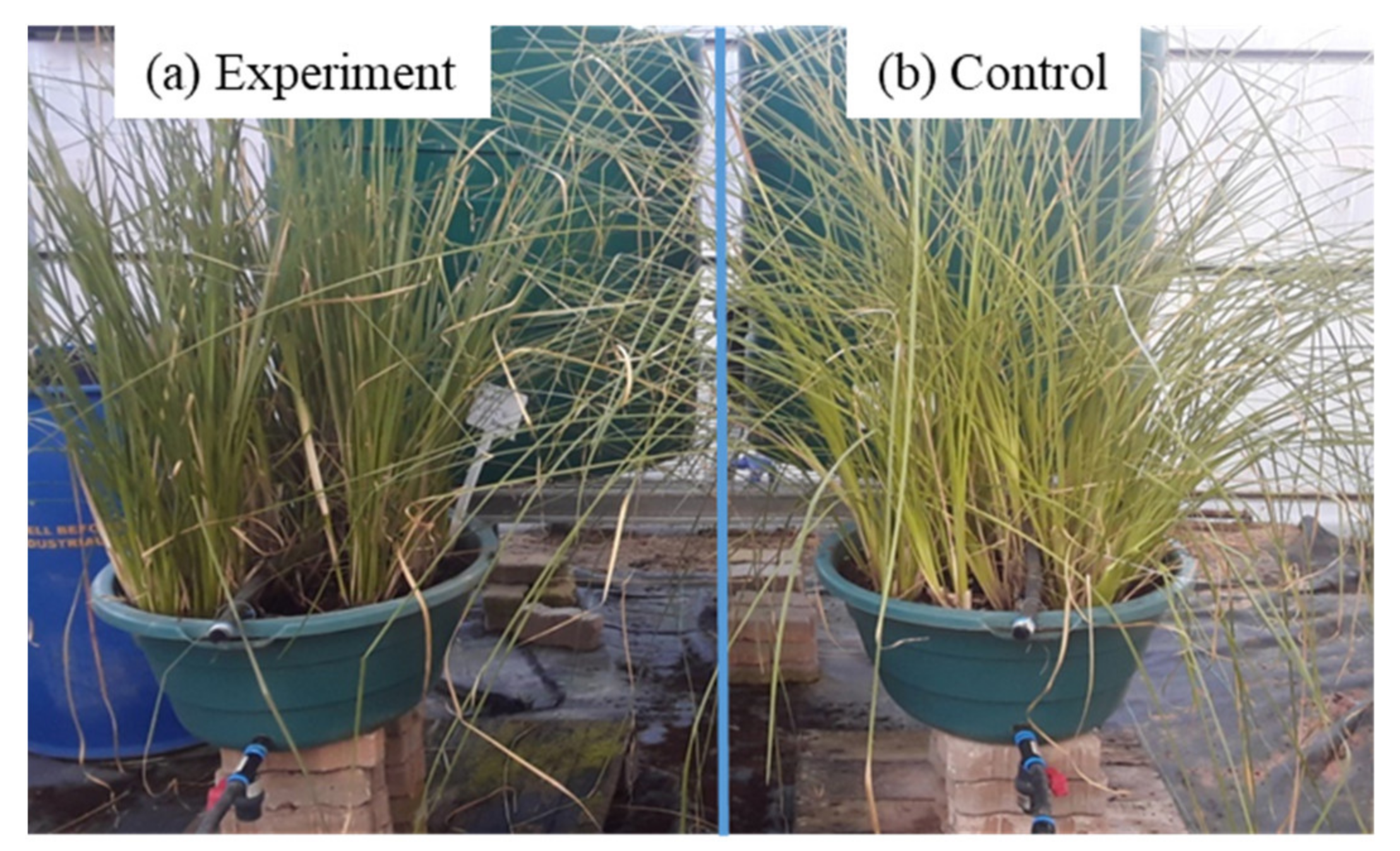
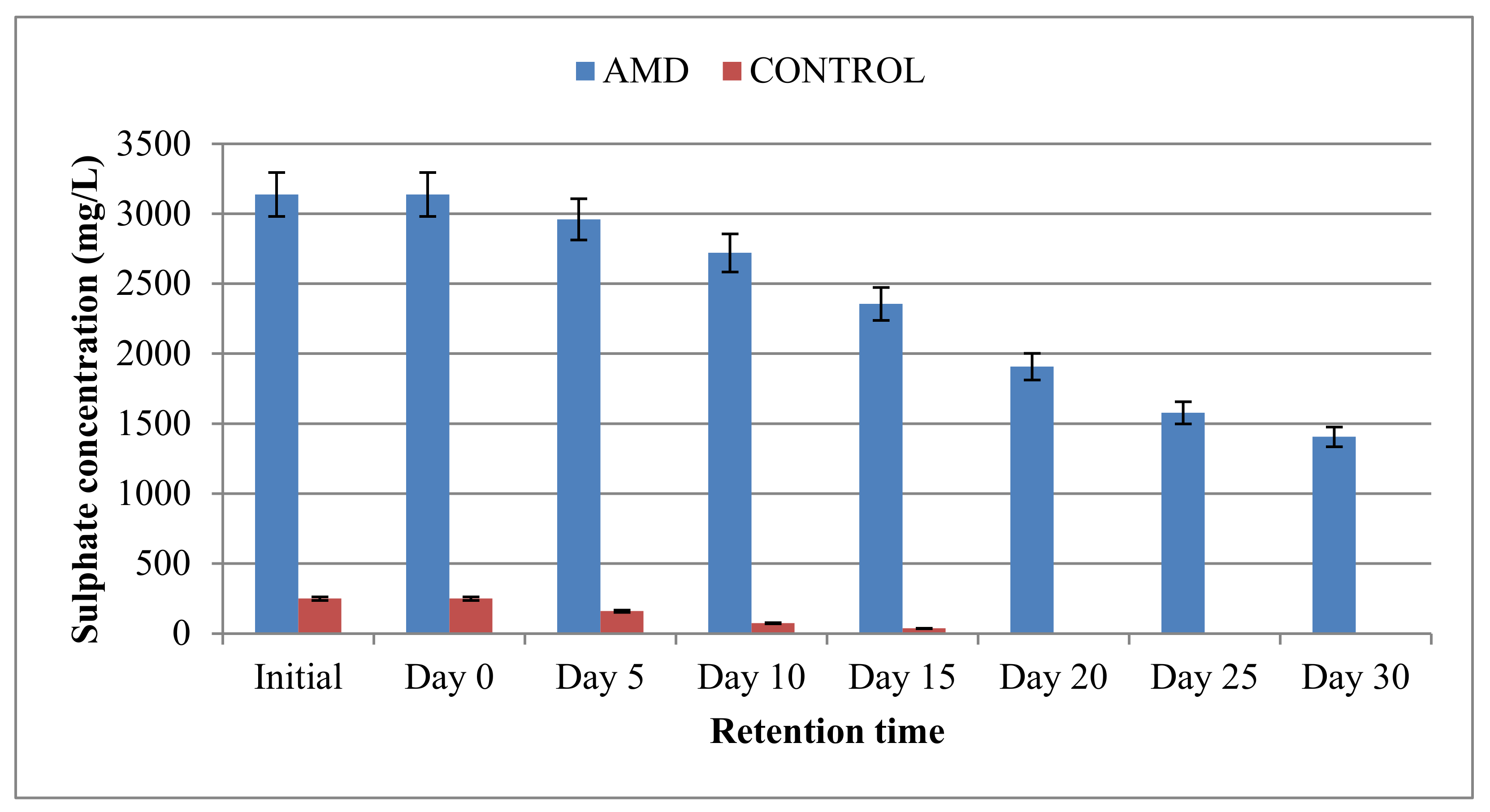
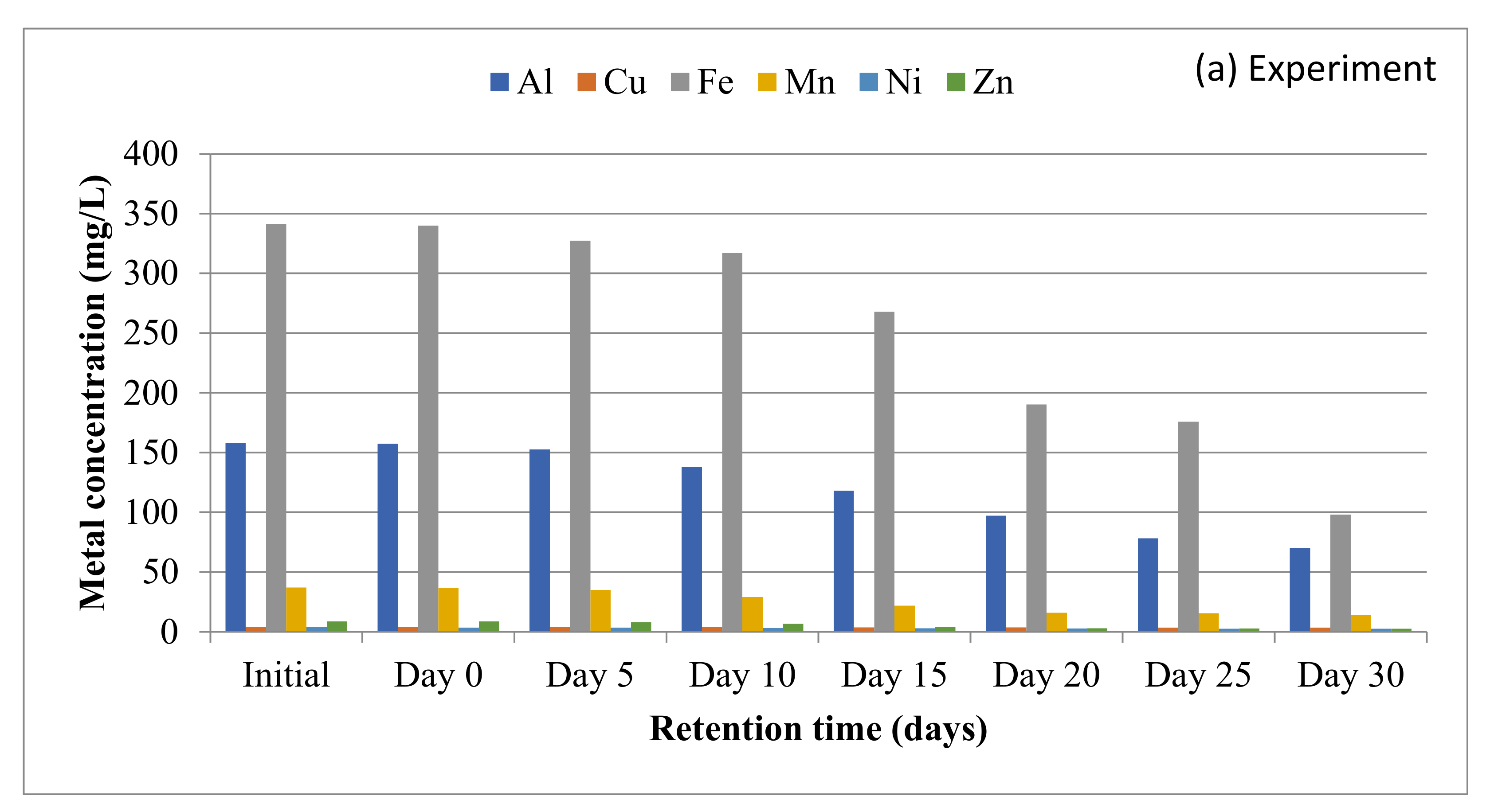
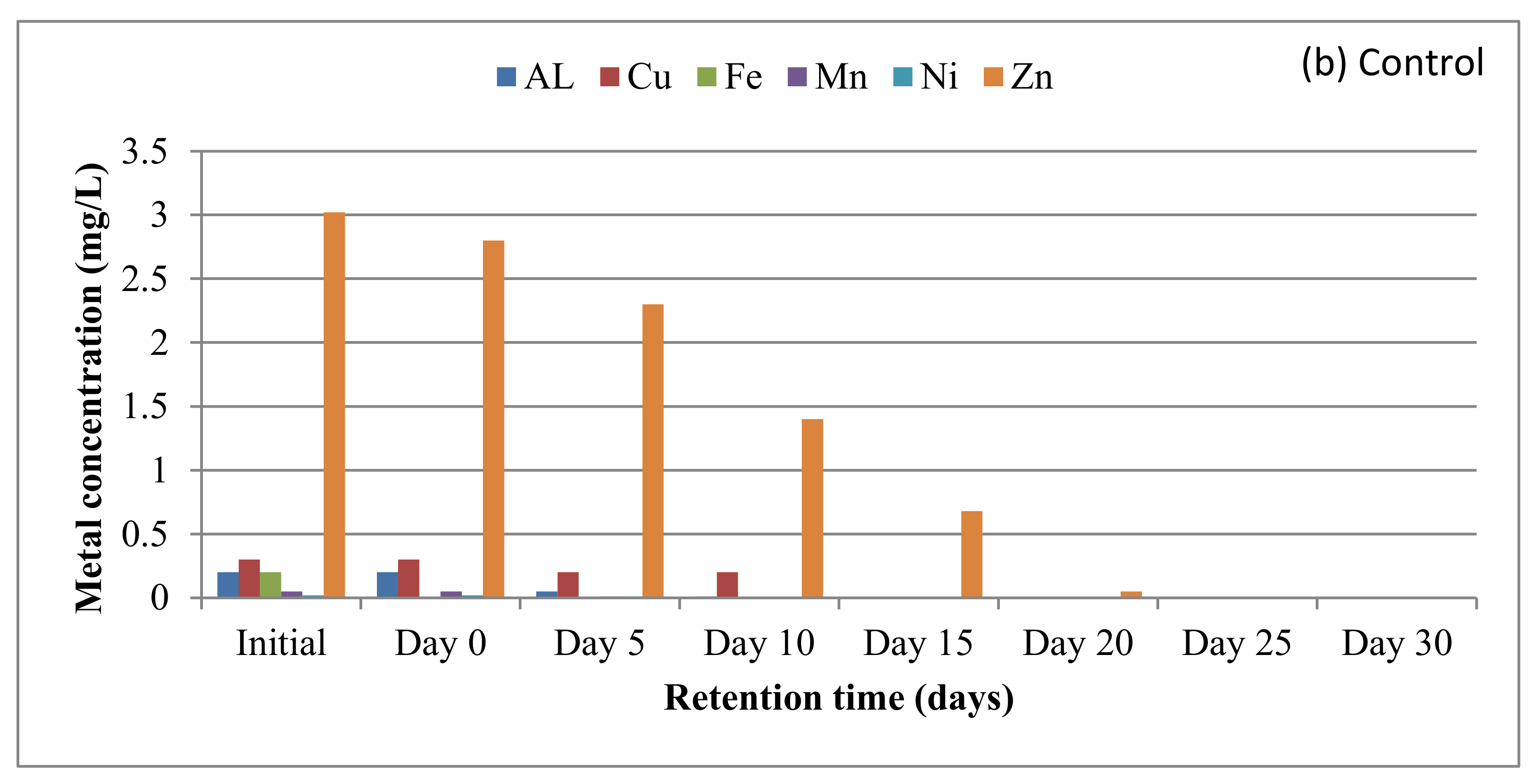
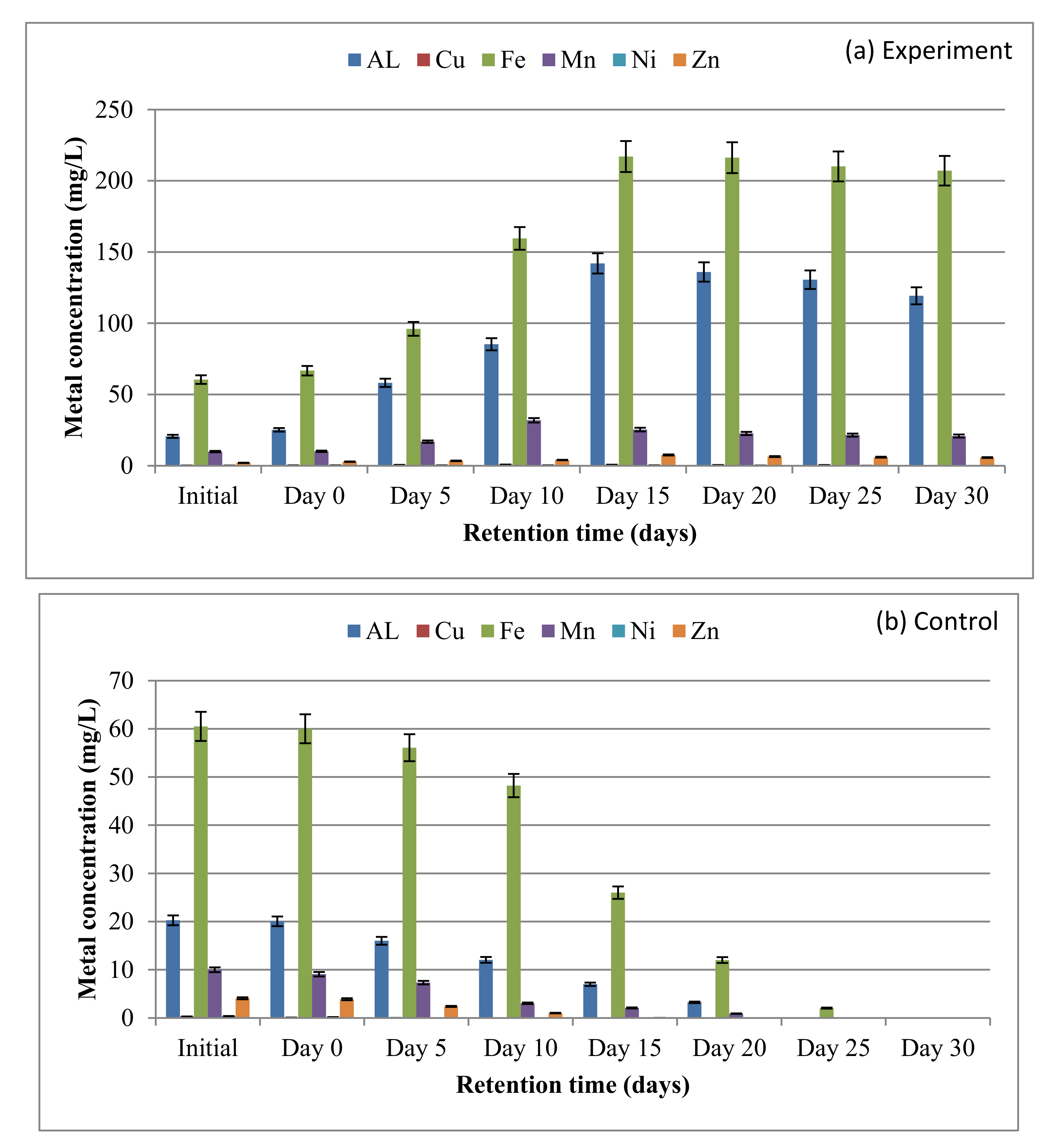

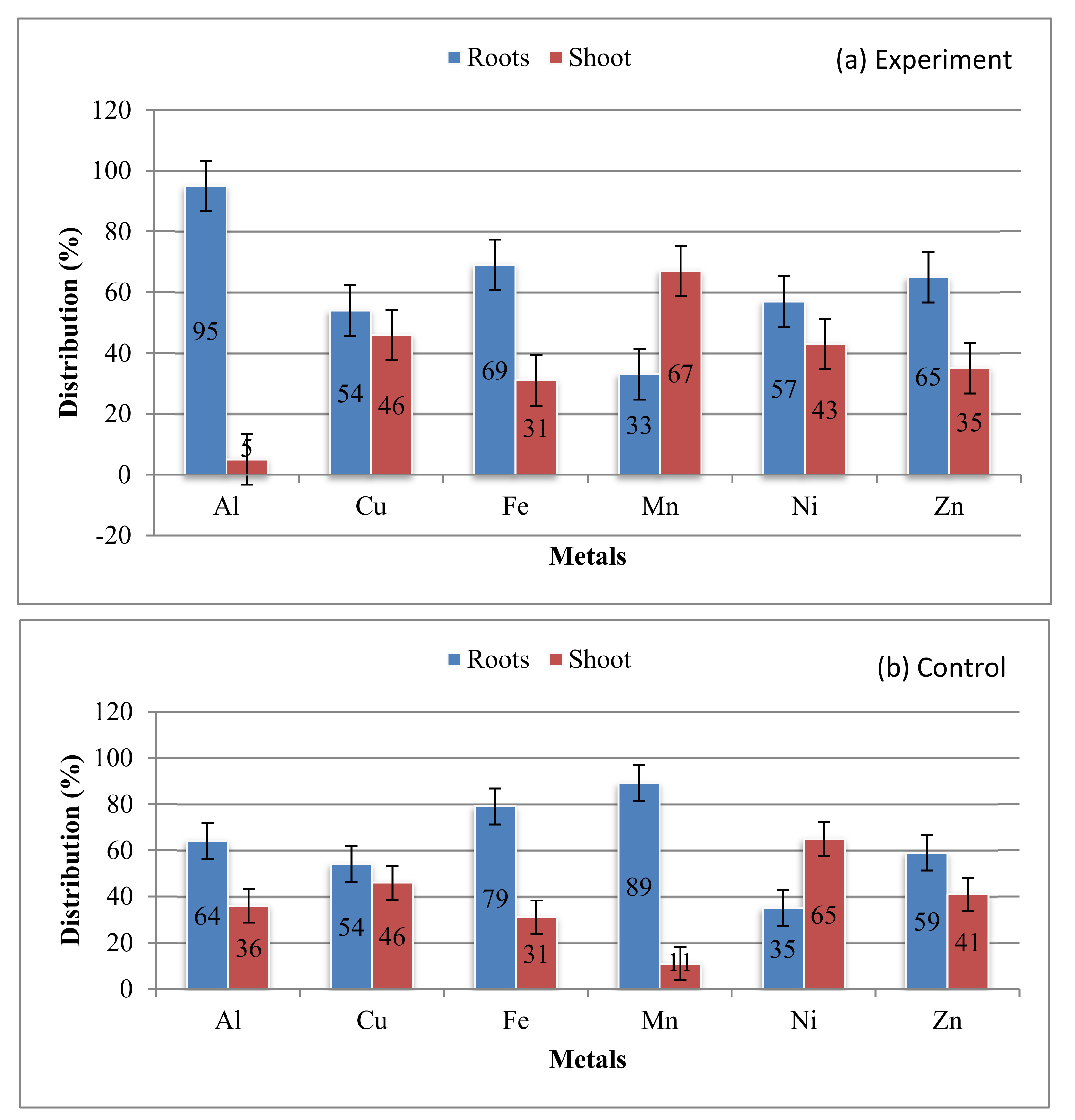
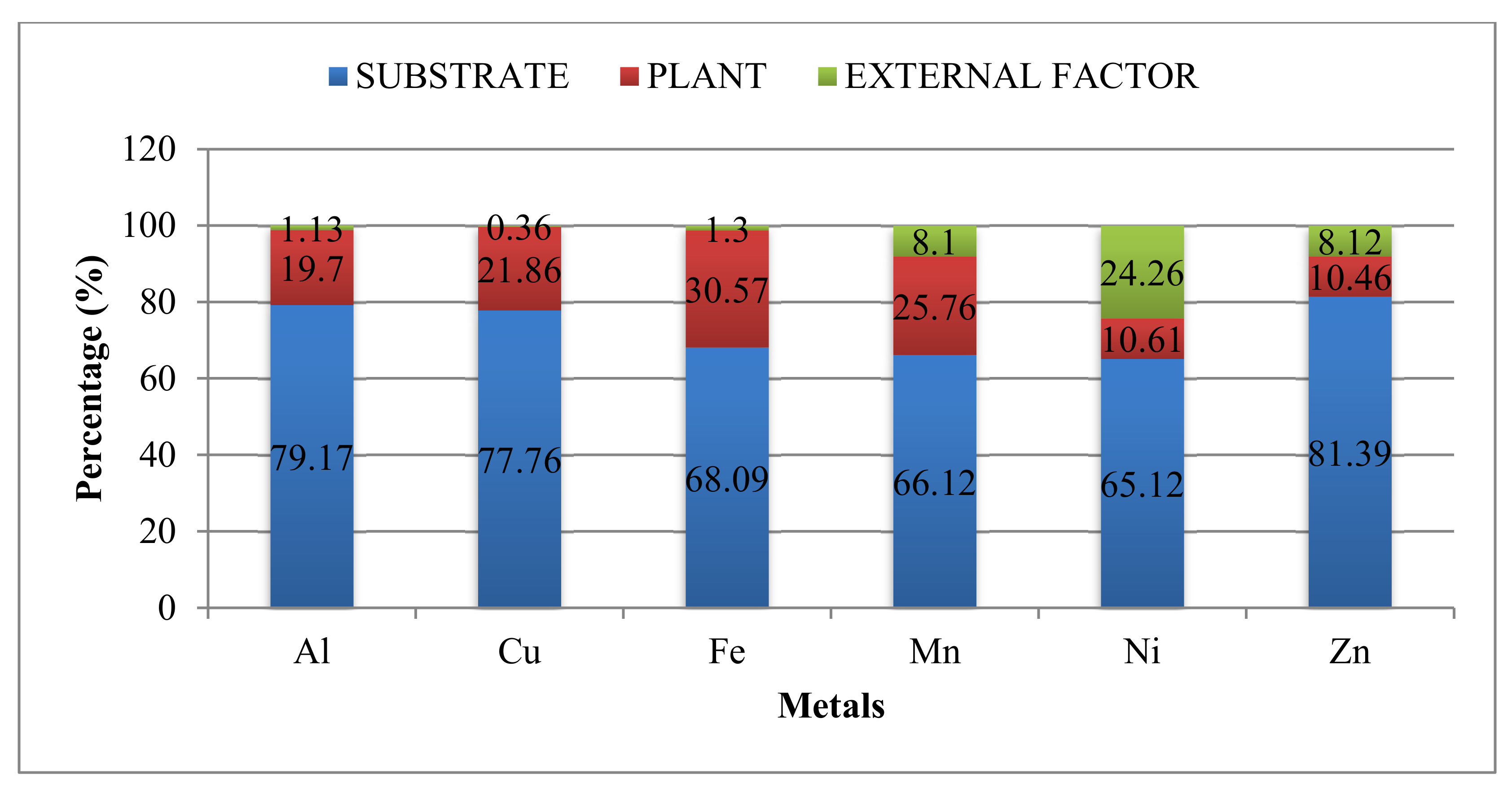
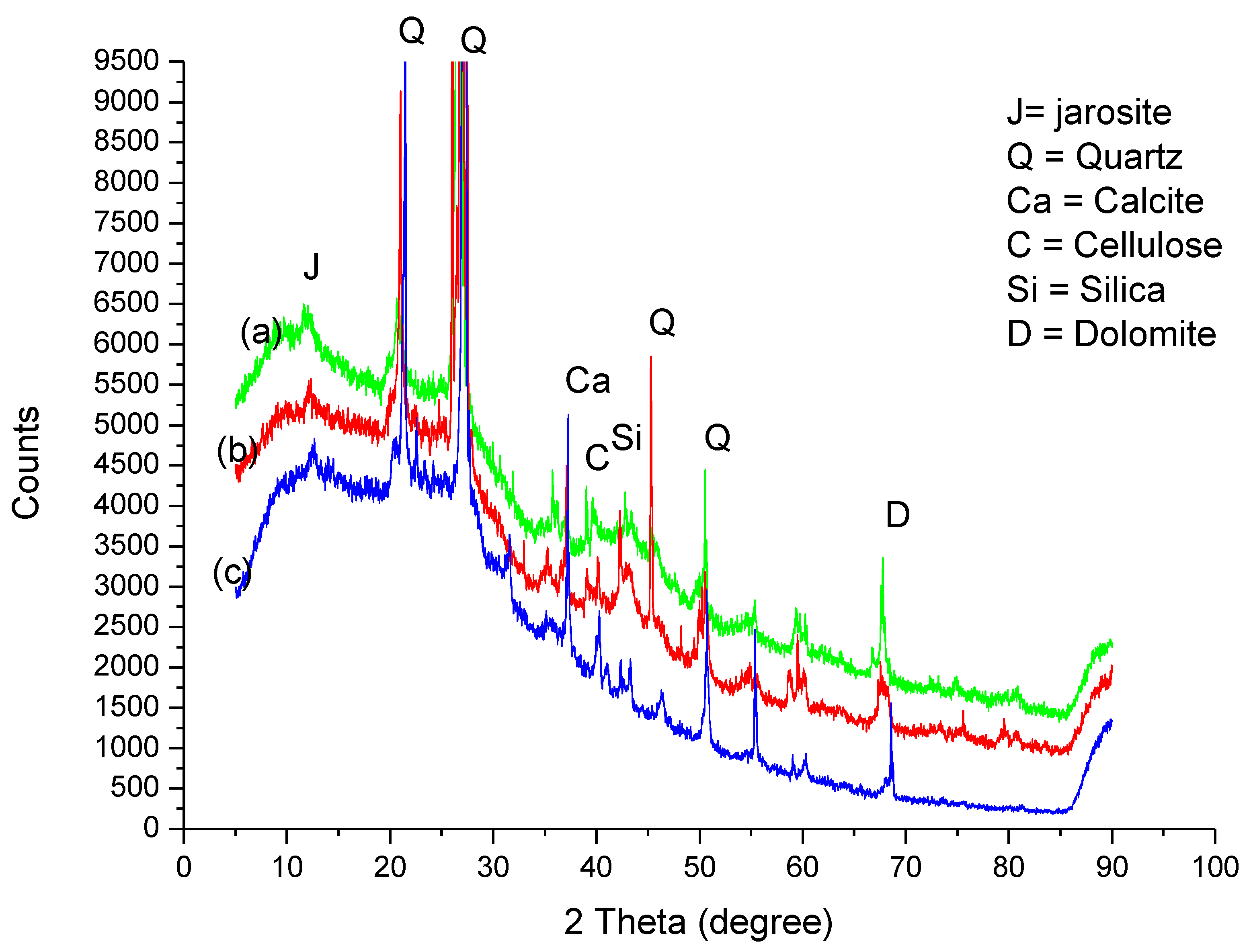



| Metals | Al | Cu | Fe | Mn | Ni | Zn |
|---|---|---|---|---|---|---|
| BCF | 0.25 | 0.81 | 0.75 | 0.42 | 0.58 | 0.24 |
| TF | Al | Cu | Fe | Mn | Ni | Zn |
|---|---|---|---|---|---|---|
| AMD | 0.05 | 0.85 | 0.44 | 2.06 | 0.75 | 0.53 |
| CONTROL | 0.03 | 0.83 | 0.27 | 0.12 | 1.85 | 0.41 |
| Samples (wt.%) | Initial Soil | Control Soil | AMD Reacted Soil |
|---|---|---|---|
| Fe | 84.9504 | 84.9532 | 88.8688 |
| Ti | 4.6093 | 2.6774 | 4.3403 |
| Rb | 3.2519 | 3.8190 | 2.3403 |
| Sr | 2.7486 | 3.7355 | 2.7808 |
| Mn | 2.3030 | 2.6018 | 3.4293 |
| Zn | 0.6970 | 0.7001 | 0.4873 |
| Si | 0.1393 | 0.3210 | 0.0291 |
| Al | ---------- | --------- | 0.0393 |
| Na | ---------- | --------- | 0.0324 |
| Ni | 0.4505 | 0.0007 | 0.0291 |
| Substrate | 2 Theta (Degree) | Mineral Phase | References |
|---|---|---|---|
| Initial soil | Quartz | 21 | [96] |
| Quartz | 28 | [96] | |
| Calcite | 37.5 | [97] | |
| Cellulose | 40.1 | ||
| Silica | 46 | ||
| Quartz | 50 | [96] | |
| Quartz | 55 | [96] | |
| Dolomite | 68 | ||
| Soil from control wetland | Quartz | 21 | [95] |
| Quartz | 27 | ||
| Calcite | 37 | ||
| Cellulose | 38 | [98] | |
| Silica | 44 | ||
| Quartz | 45 | [96] | |
| Quartz | 50 | [96] | |
| Dolomite | 67 | [99] | |
| Soil from treatment wetland | Jarosite | 8 | [98] |
| Quartz | 21 | [96] | |
| Quartz | 26 | [96] | |
| Calcite | 35 | [99] | |
| Silica | 42 | [96] | |
| Quartz | 45 | [98] | |
| Quartz | 50 | ||
| Quartz | 55 | [96] | |
| Calcite | 61 | [98] | |
| Dolomite | 65 | [99] |
| Wavenumber | Functional Group | Reference |
|---|---|---|
| 698 | Fe-O | [6] |
| 780 | Si-O | [99] |
| 1080 | SO4 | [12] |
| 1559 | C=O | [100] |
| 2222 | O-H | [101] |
| 2996.5 | O-H | [99] |
| Parameters | Raw AMD | DEA/DWAS Guidelines for Effluent Discharge | AMD-Treated Water | Percentage of Pollutant Removed |
|---|---|---|---|---|
| pH | 2.6 | 6–12 | 3.8 | --- |
| TDS | 3380 | 2400 mg/L | 1400 | 58.57 |
| EC | 5000 | 150 μS/cm | 3200 | 36.00 |
| Al | 158 | 20 mg/L | 70.02 | 56.68 |
| Fe | 341 | 50 mg/L | 98.03 | 71.24 |
| Mn | 37 | 20 mg/L | 14.06 | 62 |
| Cu | 4.2 | 20 mg/L | 3.40 | 19.04 |
| Zn | 8.55 | 20 mg/L | 2.53 | 70.40 |
| Ni | 3.92 | 10 mg/l | 2.54 | 35 |
| Sulfate | 3137 | 2400 mg/L | 1406 | 55.18 |
Publisher’s Note: MDPI stays neutral with regard to jurisdictional claims in published maps and institutional affiliations. |
© 2021 by the authors. Licensee MDPI, Basel, Switzerland. This article is an open access article distributed under the terms and conditions of the Creative Commons Attribution (CC BY) license (https://creativecommons.org/licenses/by/4.0/).
Share and Cite
Nguegang, B.; Masindi, V.; Msagati, T.A.M.; Tekere, M. The Treatment of Acid Mine Drainage Using Vertically Flowing Wetland: Insights into the Fate of Chemical Species. Minerals 2021, 11, 477. https://doi.org/10.3390/min11050477
Nguegang B, Masindi V, Msagati TAM, Tekere M. The Treatment of Acid Mine Drainage Using Vertically Flowing Wetland: Insights into the Fate of Chemical Species. Minerals. 2021; 11(5):477. https://doi.org/10.3390/min11050477
Chicago/Turabian StyleNguegang, Beauclair, Vhahangwele Masindi, Titus Alfred Makudali Msagati, and Memory Tekere. 2021. "The Treatment of Acid Mine Drainage Using Vertically Flowing Wetland: Insights into the Fate of Chemical Species" Minerals 11, no. 5: 477. https://doi.org/10.3390/min11050477
APA StyleNguegang, B., Masindi, V., Msagati, T. A. M., & Tekere, M. (2021). The Treatment of Acid Mine Drainage Using Vertically Flowing Wetland: Insights into the Fate of Chemical Species. Minerals, 11(5), 477. https://doi.org/10.3390/min11050477








